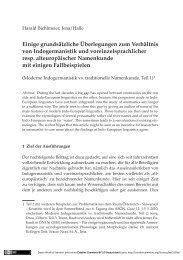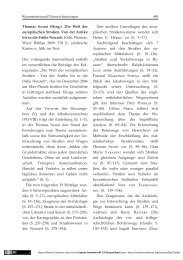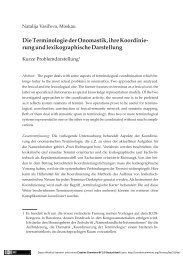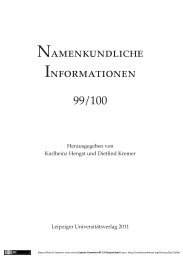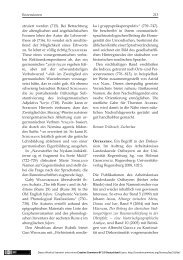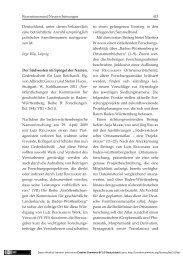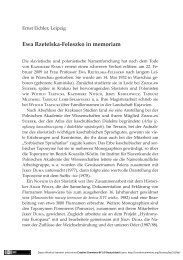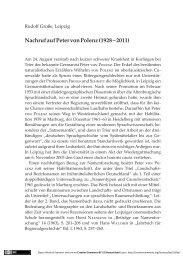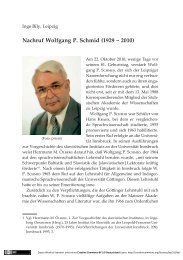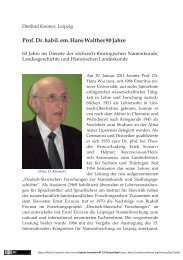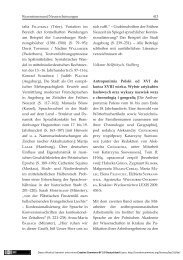Proper Names in the Light of Theoretical Onomastics
Proper Names in the Light of Theoretical Onomastics
Proper Names in the Light of Theoretical Onomastics
You also want an ePaper? Increase the reach of your titles
YUMPU automatically turns print PDFs into web optimized ePapers that Google loves.
<strong>Proper</strong> <strong>Names</strong> In <strong>the</strong> <strong>Light</strong> <strong>of</strong> <strong>Theoretical</strong> <strong>Onomastics</strong>103with<strong>in</strong> semi-<strong>of</strong>ficial and private relations. Differentiation between <strong>of</strong>ficialand un<strong>of</strong>ficial nam<strong>in</strong>g is <strong>of</strong> essential significance, especially <strong>in</strong> anthropomastics.2.2 Functional and system view <strong>of</strong> onymyThe above facts lead on to some general observations:1. Specifically onymic semantic elements are a content component <strong>of</strong> anonymic sign. A proper name is a l<strong>in</strong>guistic sign (e. g. on personal name,Horecký 2005) but it must be stressed: as a l<strong>in</strong>guistic sign sui generis. Thecontent and form <strong>of</strong> an onymic sign are closely <strong>in</strong>terrelated and at a propriallevel <strong>the</strong>y have a specific form. The <strong>in</strong>terrelations <strong>in</strong> <strong>the</strong>ir contentand formal aspects are discussed <strong>in</strong> detail below.2. On <strong>the</strong> basis <strong>of</strong> <strong>the</strong> above analyses, it is possible to formulate a certa<strong>in</strong>conclusion about <strong>the</strong> structural organisation <strong>of</strong> onymy. Individual classes<strong>of</strong> proper names are not only open sets <strong>of</strong> onymic entities; <strong>the</strong>y are als<strong>of</strong>unctionally organised subsystems. The def<strong>in</strong>ition <strong>of</strong> terms and categories<strong>of</strong> function and feature makes us better able to comprehend <strong>the</strong> functionalpr<strong>in</strong>ciple <strong>in</strong> onomastics. For example, R. Šrámek develops his argumentson this topic as follows: A function <strong>of</strong> <strong>the</strong> form Brno is to identify a certa<strong>in</strong>object and differentiate it from o<strong>the</strong>r objects <strong>of</strong> its class. Generally speak<strong>in</strong>g,<strong>the</strong> term function can be def<strong>in</strong>ed as “ to be someth<strong>in</strong>g, to exist, act assometh<strong>in</strong>g ”. “ Function is an expression <strong>of</strong> <strong>the</strong> ability to apply certa<strong>in</strong>feaures by ei<strong>the</strong>r differentiation or <strong>in</strong>tegration”…“ The proprial functionbecomes <strong>the</strong> content <strong>of</strong> <strong>the</strong> proprium” (Šrámek 1999, 21). This viewpo<strong>in</strong>t,<strong>in</strong> its substance, develops on <strong>the</strong> well-known <strong>the</strong>sis by G. Frege (1892)who claims that “<strong>the</strong> mean<strong>in</strong>g <strong>of</strong> a proper name is <strong>the</strong> object itself ”. AlsoR. Carnap (1956) sees <strong>the</strong> existence <strong>of</strong> an <strong>in</strong>dividual term <strong>in</strong> <strong>the</strong> objectwhich it names. By contrast, <strong>the</strong> category feature “<strong>in</strong>volves a range andtype <strong>of</strong> semantically dist<strong>in</strong>ctive characteristics which determ<strong>in</strong>e or specifyan extent and type <strong>of</strong> functions…and functional action”. The feature, <strong>the</strong>n,is “<strong>the</strong> ability to grasp <strong>the</strong> semantic content <strong>of</strong> a function and its orientation”. It can be concluded that, <strong>in</strong> onymy also, categories such as function,functionality and feature establish <strong>the</strong> basic organis<strong>in</strong>g systematis<strong>in</strong>g pr<strong>in</strong>ciple.Due to its functionality, onymy also has a systematic character and“langue” character. Kalverkämper (1998) and Kohlheim (1997 ) hold similarviews. This def<strong>in</strong>ition belongs to a broader research context <strong>in</strong> whichsystematisation is def<strong>in</strong>ed as a unity and coord<strong>in</strong>ation <strong>of</strong> functional, model



